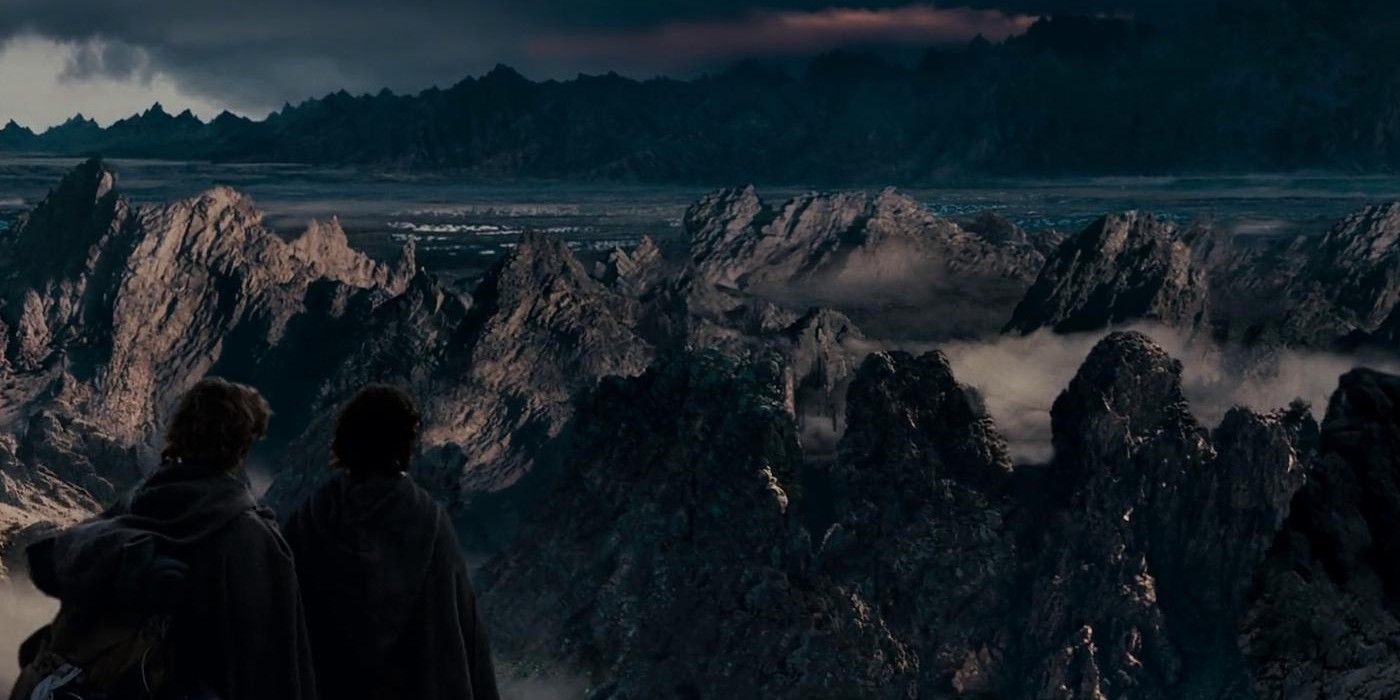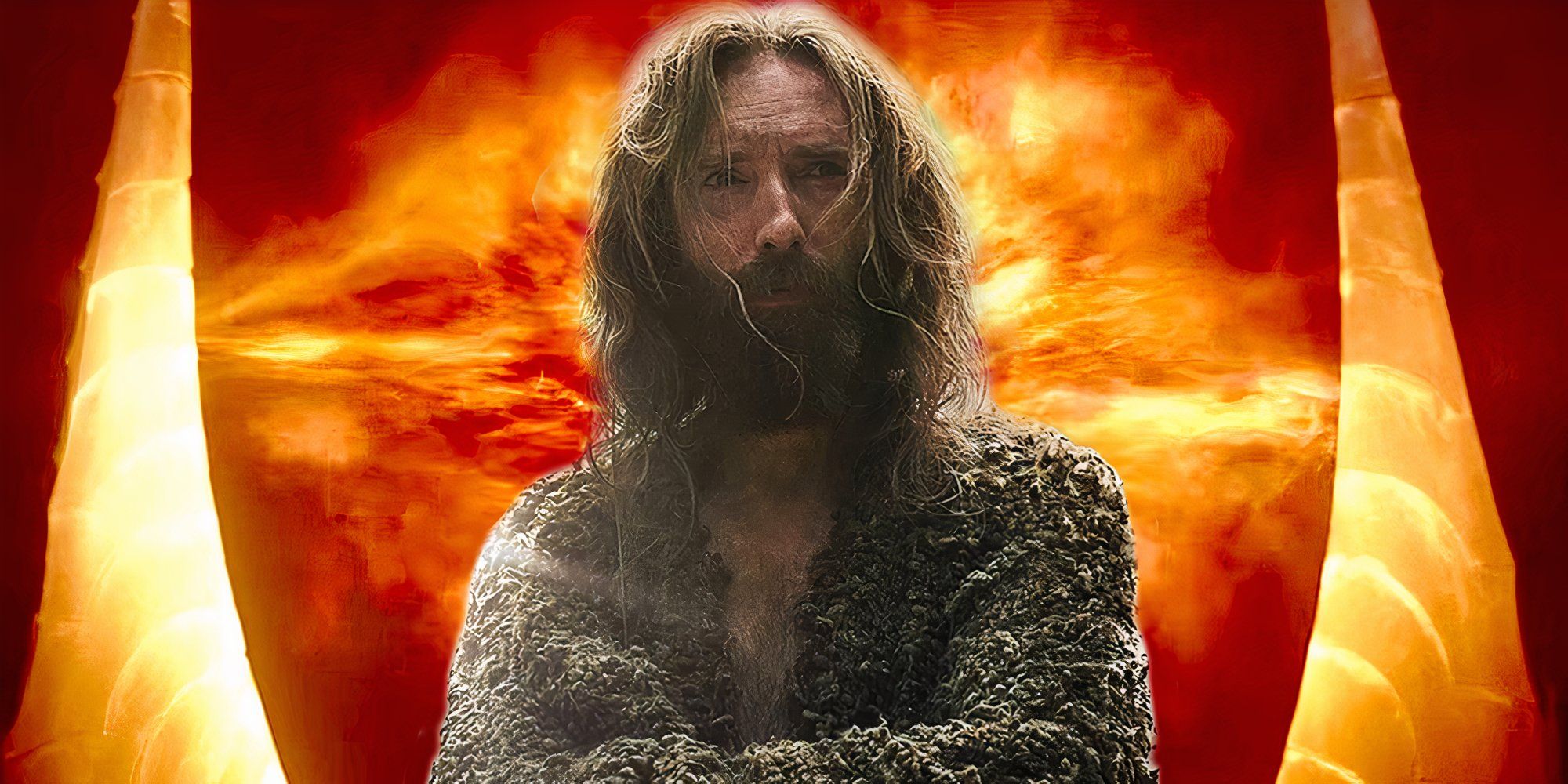
Essentially, an ancient key switches on a dormant Southlands volcano. The resulting cataclysm brings forth ash, steam, fire, rock, water and, most of all, misery, and by The Rings of Power season 2, the transformation of the Southlands is well underway. However, even for a being as powerful as Sauron, morphing a relatively pleasant land of plains and mountains into hell on Middle-earth is no simple feat. One does not simply turn the Southlands into Mordor — it’s a process of epic proportions that begins with a disgruntled tavern owner and ends with a permanent scar upon the map.
The Black Sword Key – Who Created It & Why?
Sauron May Be The Chief Architect








The — quite literal — key to turning the Southlands into Mordor proves to be the broken black sword kept hidden by Morgoth loyalist Waldreg. The weapon slots into an ornate hole at the Elven watchtower of Ostirith and begins a chain of events that give rise to Mordor — but who constructed this mechanism, and for what purpose?
Although Ostirith is occupied by Elves when The Rings of Power begins, the magical black sword and skull mechanism obviously aren’t their doing. The Southlands fought for Morgoth during the War of Wrath, so Ostirith was once under the control of the dark forces of Middle-earth, meaning the sinister key and its corresponding doom-switch were likely forged during this period.
It can also be assumed this dark machinery built into the mountain wasn’t just for some mundane purpose like opening the dam or changing water levels. Not even a showman like Sauron would craft a magic black sword with a giant skull lock for such an ordinary reason. Whoever made this lock-and-key combo apparently had the formation of Mordor in mind from the beginning.
The Rings of Power hasn’t yet offered enough information to say whose mind the Mordor master plan originated from. The black sword dates back to Morgoth, but Morgoth wasn’t the type to plan for his own downfall, which leans more toward Sauron as the chief architect. The Southlands-shaped sigil on Finrod’s corpse proves Sauron held an interest in the area for centuries, and the Lord of the Rings villain could’ve carried out his designs in secret.
Adar’s influence can’t be discounted either, of course. Motivated to find a permanent home for his Orcs, the Moriondor may have laid the foundations of his plan while serving Morgoth, then finally enacted them during the Second Age (although you could question whether Adar is powerful enough to craft such a cursed sword).
How The Southlands’ Transformation Into Mordor Begins
The Terraforming Of Moror Was A Plan With Many Phases






The Rings of Power‘s Ostirith tower is located on the eastern side of the Ephel Dúath mountain range (red circle on the map above), meaning the offending waterway could be either the Poros, or some tributary of Middle-earth’s huge River Anduin. Regardless, turning the black sword lowers the wall holding this water back, and the course cascades down the rocky cliff, destroying part of Ostirith’s battlements on its way (further proof that the release system wasn’t designed for regular dam control).
Once the water hits the bottom level, it flows into a cavern and through a system of tunnels and trenches. These are the very same tunnels and trenches that Adar’s Orcs have been digging ever since their Southlands invasion began. Their purpose, The Rings of Power season 1, episode 6 confirmed, was to direct the flow of river water on a specific course through the Southlands.
Thanks to the scenes of destruction witnessed by Galadriel and the other victorious warriors, it’s known the water passes through the village Tirharad (yellow circle), as well as Hordern (green circle), which was excavated by Orcs earlier in The Rings of Power. All the various underground tunnels feed into a central overground trench dug by Arondir and the other prisoners, which carries the water north to an inactive volcano — the future Mount Doom.
The Rings Of Power’s Volcano Explosion Is (Mostly) Accurate
Scientific Eruption With Magic Elements

.jpg)



.jpg)


Weirdly for a world that boasts immortal wizards and ghost armies, The Rings of Power‘s volcanic eruption is more or less plausible, scientifically speaking. The meeting of cool water released from Ostirith with the magma bubbling peacefully beneath Halbrand’s Southlands kingdom creates a massive amount of steam within a confined space, which in turn leads to a violent phreatomagmatic eruption churning out magma, ash and pyroclastic fragments, as well as generating extraordinary heat.
Even the thunderstorms triggered within the eruption’s ash cloud are semi-based in scientific fact, since such weather typically occurs due to warm air and water particles rising. Warm air and water is exactly what’s rising in The Rings of Power‘s explosive episode 6 ending, so while the thunderstorms may happen very quickly, they’re not just present for dramatic flair.
It’s also important to remember that this particular eruption was triggered by a magic black sword, so there’s very likely an element of sorcery to The Rings of Power‘s volcano compared against real-world phreatomagmatic eruptions. Mount Doom is, after all, where Sauron’s One Ring will be crafted, making it special even within the context of Middle-earth. The eruption itself may be triggered by science, but one cannot rule out Morgoth or Sauron weaving a touch of dark magic into the process. In J.R.R.
Tolkien’s original books, the sorry state of Mordor isn’t merely the result of volcanic activity (natural or otherwise), but also the foul presence of Sauron and his minions — a factor The Rings of Power hinted at previously with its black cow goo. This would explain why the phreatomagmatic eruption’s consequences continue for thousands of years into The Lord of the Rings‘ era.
How The Rings Of Power’s Southlands Will Change
The Eruption in The Rings of Power Will Change Southlands in Various Ways










The main purpose of The Rings of Power‘s eruption — at least for Adar — is generating a massive plume of steam and ash that covers the sky, thus blocking out all sunlight, which Orcs have a bad allergic reaction to. Even during Frodo’s journey, Mordor is renowned as a realm cloaked in darkness, and those days begin when Waldreg turns the sword-key in The Rings of Power.
Darkness isn’t the only outcome of Adar’s Southlands transformation project, however. Where Orcs tunneled upwards into settlements such as Tirharad and Hordern, water now bursts through the cavities, turning the Southlands’ smooth plains into Mordor’s craggy landscape. The trench carved out by Adar’s prisoners isn’t vanishing anytime soon either, leaving a huge permanent gash all the way from Ostirith to Mount Doom. Any Southlanders who think they could endure a few potholes and a surprise river should think again.
The flying rocks and clouds of steam emanating from Mount Doom’s eruption will destroy settlements, while the oppressive heat will make living and farming in the area all but impossible. Even during the War of the Ring, Mordor is largely inhospitable for any race but Orcs, and intense heat isn’t the only factor behind the Southlands’ newly-barren landscape — the volcanic activity could produce sulfur dioxide, stunting nearby plant growth.
How Much Of The Southlands Will Be Affected By Mount Doom’s Eruption
Northwestern Valley of Udûn Will Be Heavily Impacted






J.R.R. Tolkien’s mythology can provide some idea of how far the Southlands’ devastation in The Rings of Power episode 6 will spread. The aftereffects of Mount Doom’s eruptions (red circle) will stretch from the northwestern valley of Udûn and Sauron’s Black Gate south toward Tirharad and southeast to the Plateau of Gorgoroth.
Beyond Gorgoroth, however, is Núrn (blue circle) — a region of Mordor less stricken by Mount Doom’s assaults and hospitable to a small population of Men (who were enslaved by Sauron, obviously). Núrn is described as a partially fertile region in comparison to Mordor’s northern lands, suggesting it may remain unchanged when The Rings of Power‘s Southlands transforms (or, at the very least, recovers). The evil geographical influence upon Mordor must gradually peter out from Núrn onward.
The Visual Changes Of The Southlands When It Becomes Mordor
From Rugged Wilderness To Barren Wasteland










J.R.R Tolkien didn’t actually write that much on the Southlands prior to it becoming Mordor. Unlike some other regions lost before the Third Age like the island kingdom of Númenor, there’s little to suggest that the Southlands had anything notably unique about them prior to the volcanic eruption seen in The Rings of Power. Given its proximity to the regions that will eventually become Gondor and Rohan, it’s safe to assume that the geography and wildlife in the Southlands was similar to the other human regions seen in Middle-earth.
The exception may have been the southernmost parts of the Southlands, which border on the regions of Khand and Harad. These regions of Middle-earth are where the likes of the Haradrim originate from, and have a much more Mediterranean climate to their north, and in their eastern regions a vast desert. Since The Rings of Power didn’t show all the Southlands, it’s possible that the areas bordering Khand and Harad were much more verdant and tropical compared to the other regions of Middle-earth seen in the Amazon series or Peter Jackson’s Lord of the Rings movies.
Of course, all this is rendered irrelevant once Sauron creates Mordor. The landscape of the Southlands becomes a barren, ash-covered wasteland where almost nothing can survive, much less flourish. It remains in this state for thousands of years, right up until the destruction of Sauron at the end of the Third Age. It’s not known if Mordor will ever recover thanks to the little that’s known of Middle-earth after Lord of the Rings, but it feels safe to assume the process will take centuries, if not longer.
The Role Creatures Play In The Transformation Of The Southlands
Mordor Becomes The Realm Of The Orcs










Of course, it’s not just the landscape of the Southlands that dramatically changes when it becomes Mordor. The local wildlife and inhabitants change too, as the area is no longer suitable for humans, elves, or any of the wildlife of other regions of Middle-earth. As The Rings of Power shows, the Orcs of Middle-earth didn’t have a land to call their own after the death of Morgoth. While it’s a land of evil and darkness, a silver lining of the transformation of the Southlands into Mordor was that it provided a homeland for the Orcs.
With Orcs arriving in Mordor in their thousands, they brought with them many types of wildlife that would become synonymous with the region. Wargs, for example, and trolls (who could survive in Mordor without risk of being turned into stone due to the perpetual clouds of ash keeping the sun blocked out). The ramshackle structures built by the orcs over the centuries that followed added to the overall forboding aesthetic of Mordor, and increased its stark contrast to the other regions of Middle-earth.
Why The Transformation Of The Southlands Into Mordor Important
The Eruption Created A Perpetual Threat










In many ways it’s obvious why the Southlands becoming Mordor in The Rings of Power is important. Mordor is, after all, the final destination of Frodo’s quest in The Lord of the Rings, and where the final battle against Sauron takes place in both of the wars against him. However, there are some important points to consider when it comes to the impact the change had in-universe for the citizens of Middle-earth who existed beyond the Southlands themselves.
Thanks to Morgoth, the races of Middle-earth were no strangers to threat. However, once Mordor was created, the danger existed right on their doorstep in a way it never had before. Perhaps only the dwarfs, whose digging beneath their fortress-cities brought them forever close to some of the more dangerous creatures of Middle-earth, knew how to exist with evil so close and (literally) on the horizon.
Being able to see the fiery Mount Doom on the skyline would have brought evil closer to the hearts and homes of most of the inhabitants of Middle-earth in a way few would have known before (especially humanity). For those alive during the creation of Mordor in The Lord of the Rings: The Rings of Power, the time prior to the eruption of Mount Doom would likely come to be known as an era of, if not literal peace, but peace of mind at the very least, and one that wouldn’t be seen again for many, many millennia.




